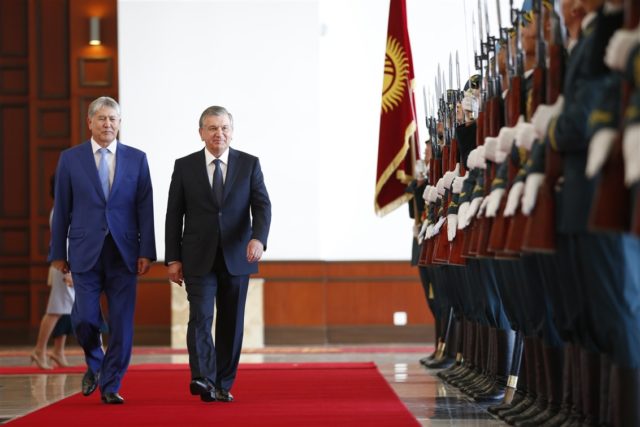
Rapprochement With Kyrgyzstan: Mirziyaev’s Greatest Foreign Policy Achievement to Date
Publication: Eurasia Daily Monitor Volume: 14 Issue: 113
By:

Until September 4, 2017, the president of Uzbekistan had not paid a state visit to Kyrgyzstan in 17 years. But Uzbekistan’s new head of state, Shavkat Mirziyaev, is determined to build a “security belt” around his country. And this has served as a catalyst to overcome the animosities of his predecessor and rebuild relations with the Kyrgyz Republic, the neighbor with which Uzbekistan has had the most difficult relations since independence from the Soviet Union. Undefined border lines, disputes over cross-border water supplies, and a stalled railroad line from China to Uzbekistan traversing Kyrgyzstan were just the most prominent sticking points that have for decades soured relations between the two Central Asian republics. Moreover, the clash of personalities of Uzbekistan’s previous president, Islam Karimov, and outgoing Kyrgyzstani President Almazbek Atambaev was no less of a contributing factor (Gezziter.org, May 21, 2015).
During his state visit to Kyrgyzstan, which took place on September 4–5, it became clear that President Mirziyaev is backtracking on a number of issues his predecessor wished not to budge. Notably, the two sides signed an agreement on demarcating 85 percent (1,170 kilometers) of the Uzbekistan-Kyrgyzstan border (Kyrgyz Television 1, September 5). To reach this point, following President Atambaev’s state visit to Uzbekistan in December 2016, border delimitation and demarcation bodies of both countries held 16 meetings after eight years of pause (24.kg August 16; Kyrgyz Television 1, September 5).
A shift toward a friendlier tone could also be observed in discussions of cross-border water-supply issues. Uzbekistan did not change its overall stance of opposing the construction of large-scale, upriver hydroelectric plants without the consent of downriver countries that share the same water resources. And yet, during this visit to Bishkek, Mirziyaev stated that the Kambar-Ata hydropower station, which has been causing significant friction between the two countries, is needed for Uzbekistan as well, even adding that Tashkent is ready to participate in the project (Regnum, March 8; 24.kg, September 5).
The China–Kyrgyzstan–Uzbekistan railroad project, on the other hand, has been on the table since 1995. Because Atambaev did not wish for his country to serve merely as a transit country for a very short stretch before the railroad reached Uzbekistan, negotiations were suspended (Azattyk, December 19, 2013). But as a result of the latest meeting, on his visit to Bishkek, Mirziyaev announced that the sides are renegotiating this project to make it more favorable for Kyrgyzstan; he promised that the railway would enter the construction phase soon (Gazeta.uz, September 6, 2017). Additionally, Mirziyaev floated a new road project: a highway from Kashgar to Andijan via Osh in Kyrgyzstan (Kloop, September 9, 2017).
It is notable that the state visit went beyond just the presidential-level meeting and did not solely revolve around the most burning issues between the two countries. For instance, the governors of Andijan, Namangan, and Fergana—regions that neighbor Kyrgyzstan—were a part of Mirziyaev’s delegation in order to extend the high-level meetings down to level of local diplomacy. Various cooperation agreements were signed: between the parliaments of both countries; between the governors’ offices of Tashkent and Bishkek regions as well as the governors’ offices of Osh region in Kyrgyzstan and Andijan in Uzbekistan; and between the two countries’ presidential strategic research institutions (Gazeta.uz, September 6). Furthermore, Mirziyaev’s meeting with the chairman of the parliament of Kyrgyzstan and other legislative leaders was a clear signal that Uzbekistan is attempting to build not only executive-level relations, but long-term links with other branches of the Kyrgyz Republic’s government (Uzdaily, September 6)
President Mirziyaev’s ability to find a common language with his Kyrgyzstani counterpart was most likely the main contributing factor to what has been achieved within a year between the two countries. These bonds were struck back in 2007, when both sitting presidents were serving as prime ministers. Moreover, Mirziyaev had located Almazbek Atambaev’s brother, who was then living in Uzbekistan and lost contact with his relatives in Kyrgyzstan (Ozodlik, December 28, 2016). Now, with both men serving as presidents of their respective countries, and compounded by the determination of the current Uzbekistani administration to overcome all obstacles to good neighborly relations, the circumstances could not have been more fortunate to improve the bilateral political situation.
Mirziyaev’s visit was the culmination of a year-long effort by various governmental agencies following then–Kyrgyzstani prime minister Sooronbay Jeenbekov’s meeting with Mirziyaev in September 2016. Much has happened since. When Mirziyaev first took the reins of the country, relations with Kyrgyzstan were at a nadir. But now the bilateral relationship may be Mirziyaev’s most successful foreign policy achievement so far: 85 percent of the shared border has finally been agreed upon, negotiations for the China–Kyrgyzstan–Uzbekistan railroad have resumed, and emotions regarding the construction of Kyrgyzstan’s hydroelectric power station have notably been softened. Mirziyaev’s speeches frequently allude to a historical duty to resolve the animosities between the two countries. And he clearly sees himself as the executor of these obligations, which helps explain the zeal with which he has been driving the process of rapprochement. The task before Mirziyaev will now be to keep this velocity going to the point of completion.



